Released 4/22/20 | Tags:
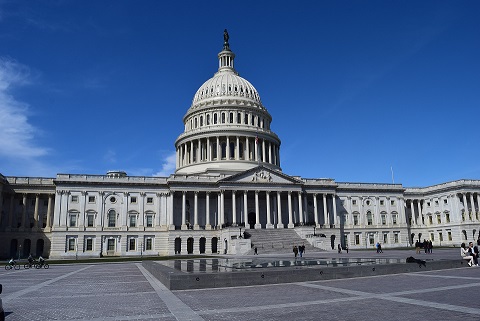
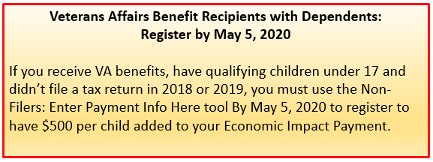
Fact Sheet on CARES Act
The National Veterans Legal Services Program (NVLSP) recognizes that veterans may have questions regarding the Coronavirus Aid, Relief, and Economic Security (CARES) Act. We have compiled the following information to help address some of the common questions.
During this COVID-19 pandemic, NVLSP continues to work to ensure that the government delivers to our veterans, active duty personnel and their families the benefits to which they are entitled due to disabilities incurred during their military service.
How Do I Get My Stimulus Payment?
Am I Eligible For a Stimulus Payment?
The recent CARES Act provides federal funds designed to help individuals in light of the COVID-19 pandemic. An individual whose adjusted gross income (AGI) is $75,000 or lower is eligible for a payment of $1,200, plus $500 multiplied by the number of qualifying children under the age of 17 claimed as a dependent. The IRS calls this payment the Economic Impact Payment (EIP), and it is also popularly referred to as the stimulus payment. The payment amount decreases as your AGI increases, until the limit of $99,000 is reached. The payment decreases at a rate of $5 for every $100 by which your AGI exceeds $75,000. In other words, individuals with an AGI above $99,000 will not receive a stimulus payment.
Married taxpayers who filed a federal income tax return jointly in 2018 or 2019 are each eligible to receive a stimulus check, up to a total of $2,400. The maximum AGI for eligibility for married couples is double that of single individuals, so that married couples who have an AGI of $150,000 or less will receive the full $2,400. That amount phases out until the AGI limit of $198,000 is reached (at a rate of $5 per $100 of AGI above $150,000), and married couples who earn more than that amount will not be eligible for a stimulus check.
Will I Automatically Get My Stimulus Payment?
Yes! The VA announced on Friday, April 17, 2020 that CARES Act stimulus (EIP) payments will automatically be processed and distributed to individuals receiving VA benefits. The payment will be sent to the bank account or address at which you normally receive your VA benefits. For individuals who are not receiving VA benefits, the stimulus payments will also be automatically processed and distributed, as long as the individuals filed a federal income tax return in 2018 or 2019 or received Social Security, Retired Railroad worker, or Supplemental Social Security Income (SSI) benefits in 2018 or 2019.
Will I Automatically Get Stimulus Payments For My Children?
No. In order to receive the $500 per dependent child stimulus payment, you must enter information into the IRS Non-Filer website. The IRS has set a deadline of May 5, 2020 for this information to be entered in order for individuals to receive dependent child stimulus payments this year. Once a stimulus payment has been issued, to an individual, that individual will not be able to use the IRS Non-Filer portal to add eligible children. By law, the additional $500 per eligible child amount would be paid in association with a return filing for tax year 2020. More information regarding the May 5 deadline is available at the IRS website: https://www.irs.gov/newsroom/va-ssi-recipients-with-eligible-children-need-to-act-by-may-5-to-quickly-add-money-to-their-automatic-economic-impact-payment-plus-500-push-continues
The IRS portal is available at https://www.irs.gov/coronavirus/non-filers-enter-payment-info-here (a link at the top right of the web page enables a Spanish-language version) and you will need to submit the following information:
• Name
• Mailing address
• Email address
• Date of birth
• Valid Social Security number
• Bank account and routing info
• IRS PIN (if in possession of one)
• Driver’s license or state-issued ID (if in possession of one)
• Information for each qualifying child
Instructions for filling out the forms at the IRS portal are available below, and individuals may contact the IRS at 800-829-1040 for additional assistance.
When Will I Receive My Payment?
The IRS has not officially stated exactly when stimulus payments will be distributed, but payments started issuing on April 9, 2020. Individuals who filed a 2018 or 2019 federal income tax return are given highest priority for receiving stimulus payments. Veterans and Supplemental Social Security Income (SSI) recipients will start receiving payments in mid-May. For individuals who did not enter direct deposit information on their federal tax returns or benefits forms, the IRS is expected to start sending paper checks in early May.
Can I Enter My Banking Information for Direct Deposit?
Yes, if you filed a tax return. On Wednesday, April 15, 2020 the IRS released an application called Get My Payment that enables individuals who filed 2018 or 2019 tax returns to enter their direct deposit banking information. The application can be accessed at https://www.irs.gov/coronavirus/get-my-payment. The application requires taxpayers to enter their adjusted gross income (AGI) from their most recent tax return, the refund or amount owed that year, and the account and routing numbers for their bank account that is to be used for direct deposit. As direct deposit payments will be made long before paper checks are sent, we recommend that anyone who has a bank account, who is not subject to debt collection (see section below on debt collectors), and who filed a tax return use this option.
Can I Track My CARES Act Stimulus Payment?
Yes. The same Get My Payment application discussed above can also be used to track the status of your stimulus payment (https://www.irs.gov/coronavirus/get-my-payment). The application requires users to submit their Social Security number, date of birth and mailing address in order to track their payment.
Will I Get a CARES Act Stimulus Payment If I Was Required to File a Tax Return in 2018 or 2019 But Did Not?
No. If you have a filing requirement and have not filed a 2018 or 2019 tax return you must file a 2019 tax return to receive your CARES Act stimulus payment. If you are unsure of whether you needed to file a 2018 or 2019 tax return, the IRS has an Interactive Tax Assistant application available at https://www.irs.gov/help/ita/do-i-need-to-file-a-tax-return.
Can a Debt Collector Take My Stimulus Payment?
Yes. The CARES Act protects borrowers with federal student loans or unpaid taxes from having their stimulus checks garnished, but it does not stop private lenders from seizing accounts or seeking garnishment based on outstanding court judgments. Various states, groups, and legislators are lobbying the Treasury Department to protect CARES Act stimulus payments from debt collectors. USAA has announced it will pause the collection of a negative account balance existing at the time the stimulus payment was deposited for 90 days, and some other banks (for example, Wells Fargo and CitiBank) have announced a similar policy. Different states have different laws on garnishment as well. While these issues get resolved, it may be beneficial for individuals in debt to receive a paper check that can be cashed or deposited in a bank that does not have a garnishment order. In order to determine the best course of action to protect stimulus payments from garnishment, we recommend individuals subject to debt collection investigate the current policies of both their bank and state, if possible.
In addition, a U.S. Treasury rule exempts from garnishment an amount in an individual’s bank account or Direct Express card equal to two months of federal VA benefit payments for that individual. The protected amount in an individual’s account does not have to come from federal VA benefits—that dollar amount is protected no matter its source. If two months of federal benefits for a VA benefits recipient is equal to $2200, the account will be fully protected from garnishment if there is only $1000 in the bank account before the stimulus payment is deposited (assuming the individual receives a stimulus payment of $1200). Once the $1200 is deposited, the total amount will still be less than or equal to $2200. Before the next VA or other benefit payment is deposited, however, the recipient will need to withdraw funds to keep the new balance under $2200.
Disclaimer: This summary is based on information disclosed by the IRS on its website as of April 27, 2020. The summary is for educational purposes only and does not constitute legal advice.
Instructions for Using the IRS Portal
The IRS portal relating to the stimulus payment (the IRS calls it the Economic Impact Payment) is: https://www.irs.gov/coronavirus/non-filers-enter-payment-info-here
At the IRS portal, you will find various information relating to the stimulus payment. Scroll down and click the blue button “Non-Filer: Enter Payment Info Here” (circled in red below):
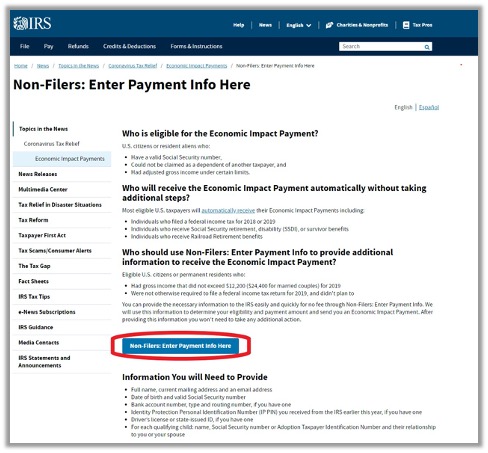
Next, review the information that is displayed regarding who should use the portal, and if the portal is applicable to you, click “Get Started” (circled in red below):
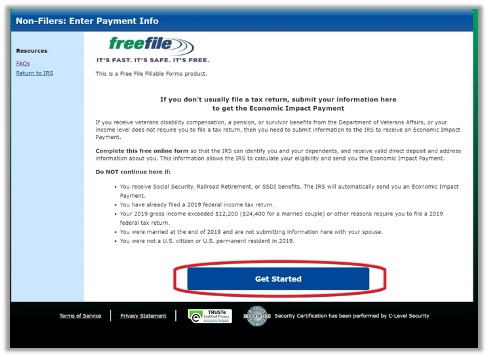
Complete the fields shown below and click “Create Account” (circled in red below). Complete the verification steps required:
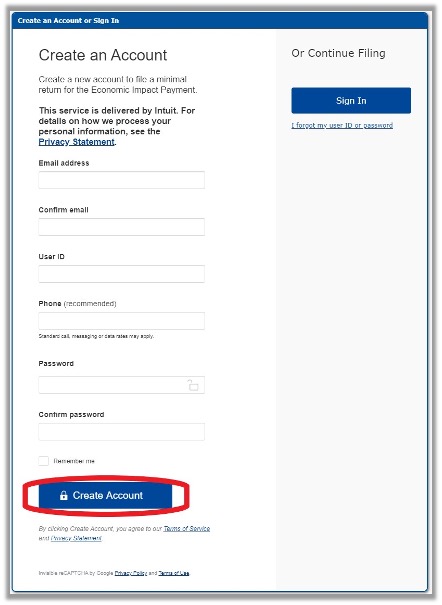
Fill in your personal and banking info at the fields shown at the tab labeled Step 1, and click “Continue to Step 2” (circled in red below):
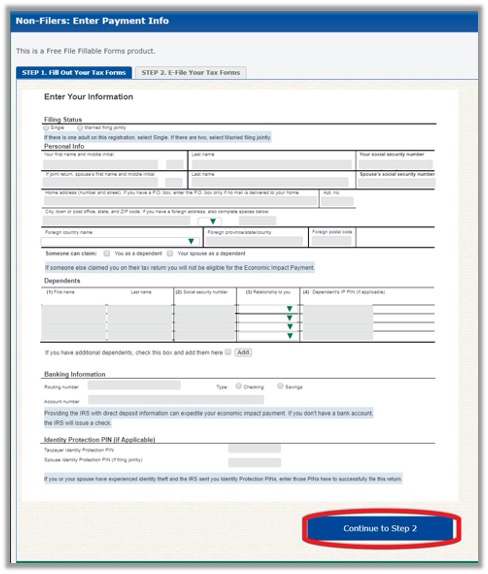
At the tab labeled Step 2, fill in your personal info at the indicated fields, and click “Continue to E-File” (circled in red below):
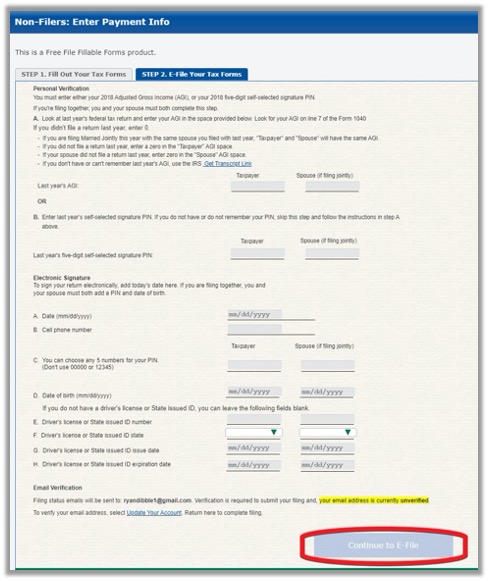
Other Resource Links:
VA Benefits and Resources Guide
Centers for Disease Control and Prevention
If you have questions regarding your COVID-19 government benefits, please contact us at info@nvlsp.org.
Stay Connected With Us:



